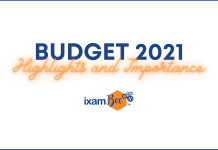National Bank for Agricultural and Rural Development (NABARD) will be releasing the notification for recruitment under Grade A posts soon. The syllabus for Economic and Social Issues paper in NABARD Grade A 2021 is vast and multiple questions are asked from Inflation topic. Following are the topics that appeared in the previous year’s Economic and Social Issues [ESI] paper of NABARD. Note that the following list is indicative and not exhaustive:
- Nature of Indian Economy
- Structural and Institutional features
- Economic underdevelopment
- Opening up the Indian Economy
- Globalization
- Economic
- Reforms in India– Privatisation
- Inflation
- Employment Generation in India – Rural and Urban
- Measurement of Poverty – Poverty Alleviation Programmes of the
- Government
- Population Trends – Population
- Growth and Economic Development – Population Policy in India
- Agriculture Industry
- Rural banking and financial institutions in India
- Reforms in Banking/ Financial sector
- Globalization of Economy
- Social Structure in India
- Education
- Social Justice
In this article we are targeting the Inflation topic from the NABARD Grade A view-point. The topic has been asked multiple times in the previous years’ paper of NABARD Grade A and is of crucial importance. Read further to know more about the Inflation, its causes, how it is measured and whether is it good or bad?
What is Inflation?
Inflation is an increase in the prices of the goods and services that households buy. It is measured as the rate of change of those prices. Typically, prices rise over time, but prices can also fall (a situation called deflation).Inflation reduces the purchasing power of each unit of currency, which leads to increases in the prices of goods and services over time. It’s an economic term that means you have to spend more to fill your fuel tank, buy a gallon of milk, or get a haircut. In other words, it increases your cost of living.
The most well-known indicator of inflation is the Consumer Price Index (CPI), which measures the percentage change in the price of a basket of goods and services consumed by households. In India, both WPI (Wholesale Price Index) and CPI (Consumer Price Index) are used to measure inflation.
Inflation Rate
The inflation rate is the percentage increase or decrease in prices during a specified period, usually a month or a year. The percentage tells you how quickly the prices rose during the period. For example, if the inflation rate for a gallon of gas is 2% per year, then gas prices will be 2% higher next year.
If the inflation rate is more than 50% in a month, that’s hyperinflation.
If inflation occurs at the same time as a recession, that’s stagflation.
Rising prices in assets like housing, gold, or stocks are called asset inflation.
The inflation rate is a critical component of the misery index, which is an economic indicator that helps to determine an average citizen’s financial health. The other component is the unemployment rate. When the misery index is higher than 10%, it means people are either suffering from a recession, galloping inflation, or both. In other words, either inflation or unemployment is greater than 10%.
What are the main causes of Inflation?
There are two causes of inflation. The most common is demand-pull inflation. That’s when demand outpaces supply for goods or the services. Buyers want the product so much that they’re willing to pay higher prices. Cost-push inflation is the second, less common, cause. That’s when supply is restricted but demand is not.
The main causes of inflation in India have been subject to considerable debates and discussions. These are some of the chief reasons for the increase in prices:
High demand and low production or supply of multiple commodities create a demand-supply gap, which leads to a hike in prices.
Excess circulation of money leads to inflation as money loses its purchasing power.
With people having more money, they also tend to spend more, which causes increased demand.
Also, note the following pointers:
Spurt in production prices of certain commodities also causes inflation as the price of the final product increases. This is called cost-push inflation.
Increase in the prices of goods and services is also a factor to consider as the involved labour also expects and demands more costs/wages to maintain their cost of living. This spirals to further increase in the prices of goods.
Measurement of Inflation in India
There are two main sets of inflation indices for measuring price level changes in India – Wholesale Price Index (WPI) and the Consumer Price Index (CPI). The WPI, where prices are quoted from wholesalers, is constructed by the Office of Economic Affairs, Ministry of Commerce and Industries. In the case of CPI (prices quoted from retailers), there are several indices to measure it: CPI for industrial labourers (CPI-IL), agricultural labourers (CPI-AL) and rural labourers (CPI-RL) besides an all India CPI.
In addition, Gross Domestic Product (GDP) deflator and Private Final Consumption Expenditure (PFCE) deflator from the National Accounts Statistics (NAS) provide an implicit economy-wide inflation estimate.
Consumer Price Index
Two Ministries – Ministry of Statistics and Programme Implementation (MOSPI) and Ministry of Labour and Employment (MOLE) are engaged in the construction of different CPIs for different groups/sectors. CPI inflation is also called retail inflation as the prices are quoted from retailers. Following are the various CPIs.
- CPI for all India or CPI combined.
- CPI for Agricultural Labourers (AL)
- CPI for Rural Labourers (RL); and
- CPI for Industrial Workers (IW)
CPI by MOSPI (CSO)
The CSO (Central Statistics Office), which comes under MOSPI, is constructing the rural, urban and the combined CPIs. They are published from 2011 onwards. Of these, the CPI combined is the most important of all the CPIs as it is relevant for all categories of people.
In April 2014, the RBI selected the all India CPI (of CSO) as the inflation index to target inflation under its new inflation targeting monetary policy framework. RBI’s decision has made the CPI as the prime inflation index.
CPIs by MOLE (Labour Bureau)
The Labour Bureau, Ministry of Labour and Employment (MOLE) is preparing different indices for various categories of people. These were CPI for Rural Laborers (CPI-RL), CPI for Agricultural Laborers (CPI-AL) and CPI for Industrial Workers (CPI-IW). There was a CPI For Urban Non-Manual Employees (CPI-UME), but it was discontinued from April 2010.
Since these CPIs were for specific categories of workers, it lacked the quality of an all India index. On the other hand, the first three indices are for specific occupational categories. The CPI compiled and released at national level by MOLE reflects fluctuations in retail prices relating to specific segments of population in the country like industrial workers (CPI-IW), agricultural laborers (CPI-AL) and rural labourers (CPI-RL).
The Wholesale Price Index (WPI)
The WPI is published by the Office of Economic Adviser, Ministry of Commerce and Industry. It has been in use since 1942 and has been published from 1947 regularly. It has a long history for serving as the nationwide inflation indicator till the emergence of the combined CPI in 2011. An important feature of the WPI which separates it from the CPI is that the prices are collected from wholesalers.
Is Inflation bad for everyone?
Inflation is perceived differently by everyone depending upon the kind of assets they possess. For someone with investments in real estate or stocked commodities, inflation means that the prices of their assets are set for a hike. For those who possess cash, they may be adversely affected by inflation as the value of their cash erodes.
Questions you can expect in NABARD ESI question paper
- Questions on economic and social welfare schemes like Pradhan Mantri Jan-Dhan Yojana (PMJDY), Jan Aushadi, Pradhan Mantri Ujjwala Yojana (PMUY), Shyama Prasad Mukherji Rurban Mission (SPMRM), Pradhan Mantri Kaushal Vikas Yojana (PMKVY), Deen Dayal Upadhyaya Grameen Kaushalya Yojana (DDU-GKY), etc. that are launched for the welfare of people in rural areas, women, children, rural youth, etc.
- Committees set up by the government like the Shanta Kumar Committee, social sector programs and missions (like Indradhanush) launched by the Government.
- Ranks of India on various indexes
- Poverty Alleviation, Population Policy in India.
- Autonomous agencies launched by the Government of India like the National Skill Development Agency launched by Ministry of Skill Development and Entrepreneurship
- Questions based on the Economic Survey
- Economic currents affairs on topics like department of disinvestment, overdrafts, etc
- Questions based on passages related to current affairs (like the firing of the air hostess, being a good Samaritan, reservations, etc.)
Study Material for Economic and Social Issues paper of NABARD
Keep your study material minimum and do not hoard too many books as it will only end up intimidating you.
The syllabus of Economic and Social Issues [ESI] of NABARD can be intimidating since it is vast. However, reading books cover to cover to understand concepts will only end up confusing you at the moment. You might even spend a lot of time on learning concepts that aren’t even in the syllabus.
Therefore, to save that effort and your precious time and energy, we recommend you take NABARD Mock Tests.
Why should you take NABARD Mock Tests?
The mock tests are prepared by experts, who know the latest NABARD ESI exam syllabus and pattern, after thorough research and analysis. They cover the most important topics in the mock tests that will appear in the exam. Taking the mock tests will give you a fair idea about the topics that will be asked, and also the pattern and difficulty level of the questions.
Using this information, you can fine-tune and tailor your Economic and Social Issues preparation and save time and energy.
Mock tests also help you analyze your performance, determine your speed and accuracy and identify your strong and weak topics in ESI section.
Take a free trial: NABARD Economic and Social Issues Mock Tests
To learn more about such concepts and get through some of the prestigious government exams visit ixambee.com. ixamBee is a one-stop solution to your preparation needs for any government exam. We cover government exams from Teaching to RBI Grade B. You can also practice questions on such concepts.
All mock tests are free at ixamBee.
Also Read:
Latest Indian Government Schemes 2019 (Part 1)
States and Union Territories Governors List
Get FreeOnline Test Series, GK updates in form ofBeepedia, as well as latest updates forBank PO,Bank Clerk,SSC,RBI,NABARDand OtherGovernment Jobs.















